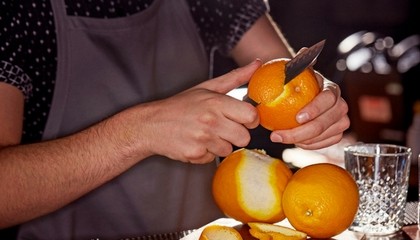Are your garnishes up to par? The creativity and thought that goes into your serve’s garnish can be the difference between unforgettable flair or a complete flop. We explore when to use which garnish and how to make sure yours are a cut above the rest.
ESSENTIAL BAR SKILLS: GARNISH
Adding Theater and Flavor to Your Serves
Although often overlooked, an inventive garnish is one of the most important components in crafting truly exceptional drinks. Not only are they visually appealing, but a creative and original garnish can also:
Provide the perfect opportunity to add a little theater to your final product.
Complement the drink’s ingredients and add further layers of flavor.
Maximize presentation, elevating the drink in the eyes of your customers and setting it apart from a similar serve they might have tried somewhere else.
Showcase your skills and attention to detail.

Garnish Trends
The fruits you choose, and how you garnish your drinks, have the ability to really make your venue stand out and give you an edge over your competitors. With so many different trends emerging across the globe, it’s important to make sure that whichever you choose to adopt, your garnishes are executed to perfection!
Tropical – Tropical cocktails are renowned for using an array of flamboyant florals to garnish their serves—they take the word "garnish" to a whole new level! Tropical cocktails have been at the front and center of garnish innovation and continue to push the boundaries.
Vintage – In the past, the main goal was to make sure that nothing went to waste and that every ingredient was recycled where possible. If a lemon was used in the cocktail, then you can be sure it was used as a garnish as well.
Modern – As the importance of the garnish has increased rapidly over the years, the world of the garnish has become more open to a huge variety of weird and wonderful inventions. Today, anything from dried flowers all the way to gold leaf can be found adorning serves.
Fresh is Best
It may seem obvious, but using higher-quality fresh fruit and herbs in both your serves and as your garnish will result in better tasting and more visually appealing drinks. Pre-packed, lower-quality fruits can have a dramatic impact on the final product and can even cost you sales in the long run.
Local produce comes with a built-in perception of freshness and quality. So, make connections with your local food wholesalers, markets/green grocers, and emphasize how you want to make a real point of difference for your outlet by being more adventurous.
Have backup supplies of fruit to cover each shift and store these in suitable containers in the fridge. Mint leaves, once washed and prepared, should be wrapped in a dampened paper kitchen towel and kept in the fridge to keep them fresh.
Which Fruits to Use and Why
Always use fresh fruit without obvious imperfections. Limes, lemons, and oranges are great options, as citrus fruits provide color, flavor, and that all-important zing of acidity.
Here are some simple rules when it comes to garnishes:
Orange for orange-flavored drinks
Lemon for lemon-flavored drinks
Lime for all other serves
Knife Skills
When crafting your garnishes, a sharper knife is easier and safer to use than a blunt blade, so having a good sharpening tool at hand is essential to ensure that utensils are ready for use at all times.
Using the right knives in the right way makes your job easier. It’s recommended that bars should have the following:
A SMALL KNIFE
For slicing, removing the ends off citrus fruits and dealing with softer fruits that are more likely to bruise.

A LARGE KNIFE
For dealing with large fruits, such as pineapples, grapefruits, etc.

A CHOPPING BOARD
Good quality, washable, toughened plastic is the best choice.
HOW TO CUT A GARNISH
Use a clean, dry knife and chopping board
Wash the fruit
Chop off the ends
Cut in half and remove the pith at the core
Slice into wedges:
Lime, 6 wedges
Lemon, 8 wedges
Orange, 16 wedges
HOW TO CUT A TWIST
Make a cut using the channel
It needs to be long enough to tie or to twist and curl
It’s best to start the twist where the fruit’s stem was
Cut in a spiral, not a straight line—use your knife to go around the fruit in a spiral
A tight spiral gives you a tight curl, a wide spiral creates a bigger, looser curl
